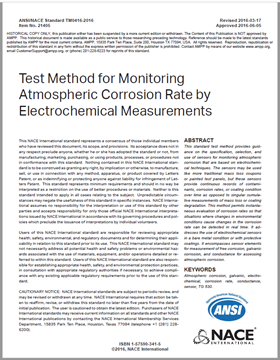Search
Standards
View as
Sort by
Display
per page
ANSI/NACE MR0175-HD2001-SG Sulfide Stress Cracking Resistant Metallic Materials for Oilfield Equipment-HD2001
Product Number:
21304-HD2001
ISBN:
1-57590-021-1
Publication Date:
2001
$179.00
ANSI/NACE MR0175-HD2002-SG Sulfide Stress Cracking Resistant Metallic Materials for Oilfield Equipment-HD2002
Product Number:
21304-HD2002
Publication Date:
2002
$179.00
ANSI/NACE MR0175-HD2003-SG Metals for Sulfide Stress Cracking and Stress Corrosion Cracking Resistance in Sour Oilfield Environments-HD2003
Product Number:
21302-HD2003
ISBN:
1-57590-021-1
Publication Date:
2003
$179.00
ANSI/NACE No. 13/SSPC-ACS-1-2016, Industrial Coating and Lining Application Specialist Qualification and Certification
Product Number:
21122-SG
Publication Date:
2015
$179.00
ANSI/NACE RP0502-2002 Pipeline External Corrosion Direct Assessment Methodology
Product Number:
RP0502-2002
Publication Date:
2002
$179.00
ANSI/NACE SP0115-2015/ISO15589-2:2012, “Petroleum, petrochemical and natural gas industries — Cathodic protection of pipeline transportation systems — Part 2: Offshore pipelines”
Product Number:
21190-SG
ISBN:
1-57590-310-5
Publication Date:
2015
$220.00
ANSI/NACE SP0300-2016/ISO 16784-1:2006, “Corrosion of metals and alloys — Corrosion and fouling in industrial cooling water systems — Part 1: Guidelines for conducting pilot scale evaluation of corrosion and fouling control additives for open recirculating cooling water systems”
Product Number:
21092-SG
ISBN:
1-57590-162-5
Publication Date:
2016
$109.00
ANSI/NACE SP0508-2017, Methods of Validating Equivalence to ISO 8502-9 on Measurement of the Levels of Soluble Salts
Product Number:
21134-SG
ISBN:
1-57590-222-2
Publication Date:
2017
$109.00
ANSI/NACE TM0284-2016, Evaluation of Pipeline and Pressure Vessel Steels for Resistance to Hydrogen-Induced Cracking
Product Number:
21215-SG
ISBN:
1-57590-163-3
Publication Date:
2016
$109.00
ANSI/NACE TM0416-2016, “Test Method for Monitoring Atmospheric Corrosion Rate by Electrochemical Measurements”
Product Number:
21405-SG
Publication Date:
2016
$179.00
ANSI/NACE TM0416-2023/ISO 22858:2020, Corrosion of metals and alloys — Electrochemical measurements — Test method for monitoring atmospheric corrosion
Product Number:
ANSI-NACE TM0416-2023-ISO 22858-2020
$149.00
ANSI/NACE/ISO MR0103-HD2010, Materials Resistant to Sulfide Stress Cracking in Corrosive Petroleum Refining Environments
Product Number:
21305-HD2010
ISBN:
1-57590-168-4
Publication Date:
2010
$179.00













